#fireball – Has it really taken the Fireball dinghy 51 years to become an overnight success in Dun Laoghaire? Not at all. They've been hugely successful here before. But there's undoubtedly a renaissance under way, and a very special re-invigoration it is too.
It was in 1962 that innovative designer and technologist Peter Milne eventually finalised the concept for a novel 16ft racing dinghy evolved from the classic American Class A Scow. By 1995 it was thriving to such an extent globally and in Ireland that the 1995 Fireball Worlds in Dublin Bay attracted 85 entries from 13 countries.
The winners of both the Europeans and the Worlds were the home talents, two young fellows from the National Yacht Club called John Lavery and David O'Brien. Wonder where they are now....probably stalwarts in some suburban bowling club. Yet in the 18 years since that Irish high point, the class at one stage almost faded completely from view, but now it is the hottest ticket in town.
Somehow, it has remained a novel boat concept ever since it was first conceived, and its minimalist and economical image fits perfectly with the needs of performance sailors in this era of acute recession. In the current winter season, the class's thriving frostbite series in Dun Laoghaire is attracting fleet numbers that other boat types would die for in summer, with an esprit de corps to match.
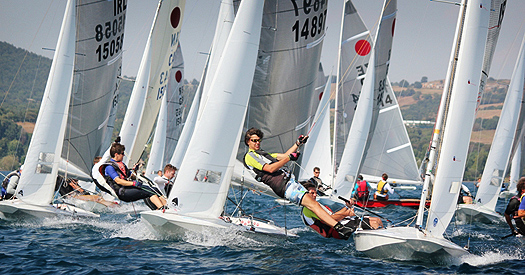
Minimalist boat, maximized sport – the Fireball is providing a cheerful and effective response to our recessionary times
The Irish Fireballs also have a busy summer programme, but there's another aspect to the class which makes them even more special. They're a hotbed for the growing number of sailors who are keen on the expanding two-handed classes which have become such an important feature of each summer's main offshore races.
Currently, the Dun Laoghaire Fireballers who have made the strongest mark on the two-handed international scene are Andy Boyle and Barry Hurley. Together, they were to win the double-handed division with Barry's JOD 35 Dinah in the Middle Sea Race at the end of October. But before that, Andy became part of an even bigger picture when he successfully stepped into a last-minute vacancy to partner Nick Martin on his J/105 Diablo J in the Round Ireland Race in June.
They won the two-handed class round Ireland, and placed 9th overall, a formidable performance. This then placed Diablo J nicely on track to win the two-handed division in the RORC's season-long points championship overall. And at the RORC's annual prize-giving in November, this all became stratospheric as Diablo-J was acclaimed Yacht of the Year.
So when you race with the Dun Laoghaire Fireballs these days, you're crossing tacks with guys who have taken on the best on the high seas, as other sailors include Brian Flahive who double-hands with Liam Coyne on the First 36.7 Lula Belle which – like Diablo-J with Nick Martin and Andy Boyle - is in the mix for this year's Fastnet Race, as too is another Dun Laoghaire Fireball Frostbite duo, Mike Murphy of Waterford and Alex Voy of Dromineer, who'll race the much-travelled JPK 9.60 Alchimiste round the rock.
The attraction of the class is that it provides so much for so little. A Fireball may be 16ft long, but look at her sideways and she's almost invisible. Be that as it may, she supports the full rig with spinnaker and trapeze, which gives the helm and crew equal status. And the Magic Ingredient is the class's supportive attitude to anyone who is involved, or maybe just thinking about joining.
They overcome the strangeness of the world of sailing for beginners or would-be Fireball sailors with an out-reaching and friendly approach which, in the final analysis, is just plain good manners and co-operation. Just what Ireland's needs to get out of the current slough. Meanwhile, the Fireballs are getting on with it, and they're attracting back former fans. Class Chairman Neil Colin is on his "second Fireball career", his enthusiasm renewed as he heads up an organization which gives all sorts of help to new owners, and knows where boats can be sourced on loan either for sailors coming from abroad to do one event in Ireland, or for a test drive for those who are beginning to think that the Fireball might just be the answer for dinghy sailing in our frugal times.
THE SECRET OF WMDWOOTY
Or Maybe Gaff Rig Wasn't So Great After All
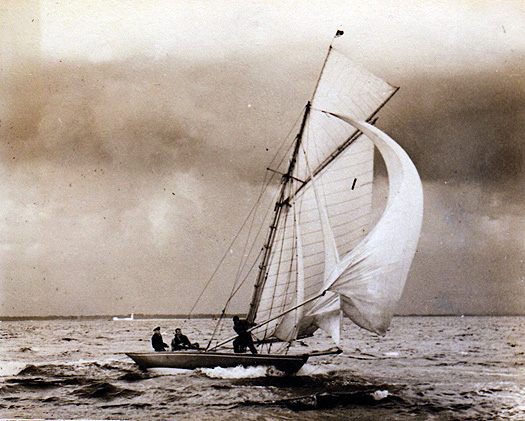
Dublin Bay 21 in a breeze under the original rig, with the helmsman looking remarkably calm despite the potential mayhem of his situation
Following last week's piece about the Golden Jubilee of the Old Gaffers Association bringing a fleet to Dublin Bay this summer, and how it was a sad coincidence that the Old Gaffers Association was founded to preserve gaff rig in 1963 at exactly the same time that the owners of the Dublin Bay 21ft ODs were converting to a more easily handled but much less spectacular Bermudan rig, we've had a robust response from Paddy Boyd in Canada. His view of the DBSC 21s in their classical prime is free of the rose tinting of our own view, and as it fairly leaps off the screen, we'll let it rip:
"I was interested in the old gaffers article, particularly as I remember, albeit not very vividly, the change to Bermudan rig in 1963 as my late father was the DB21 class captain at that time. As I recall, he had to take some stick for abandoning tradition, not least from Seamus Kelly (Quidnunc of an Irishman's Diary in The Irish Times), who was a member of his crew on the Oola.
My earliest sailing memory is as pump hand/mainsheet trimmer on the Oola, perhaps the busiest job on board in anything over a Force 3! Removing the vast amounts of cold Dublin Bay brine was, in those days, by way of a brass bicycle pump affair that leaked, by way of small but vicious jet of the aforementioned brine from the badly sealed barrel cap, directly into the mouth and nose of the operator.
Meanwhile, because the main sheet was led down below, one was always ready for the scream to ease sheets from the skipper as the volumes of water coming over the coaming approached overwhelming levels.
I haven't yet decided what was the best day of my fledgling sailing career: the day my father invested in a Whale Gusher 25, or the decision to change to a smaller, more manageable sail plan. I'm tending towards the latter.
You wrote: But please believe that in their prime, the Dublin Bay 21s were just about the most perfect, the most beautiful, the most gallant small gaff cutters ever created. With their spectacular jackyard tops'ls, they were demanding creatures. They were thoroughbreds, a joy to sail, and the providers of tremendous sport.
Beautiful? – absolutely
Demanding? – for sure,
Gallant? - maybe,
A joy to sail? – not for the pump hand/main sheet trimmer
Providers of tremendous sport? – I can't comment, because I couldn't see anything when down below upwind, and even when we bore away I was put sitting on the boom facing aft. I hardly ever saw anything of the rest of the fleet, because my Dad's greatest sailing attribute was his unfailing optimism with a tendency to take flyers, so much so that his crew made a burgee with the acronym of his most spoken phrase WMDWOOTY – "we might do well out of this yet"
But most perfect? – here I have to disagree most vehemently. Am I the only person who thinks that they were a poor design, - overcanvassed, narrow side decks allowing huge amounts of water in at relatively small angles of heel, unbalanced and inefficient requiring too many crew in too small a space?
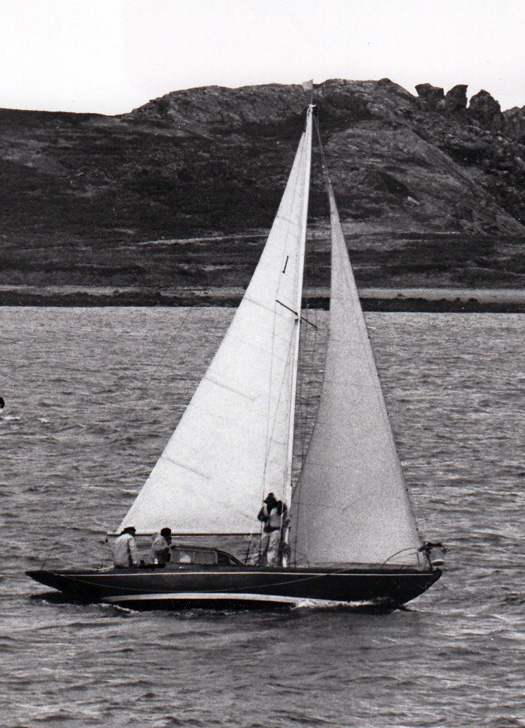
Sensible but prosaic – the new Bermuda rig kept the Dublin Bay 21s racing until 1986
The ease of handling under the new rig, allied to the extended headroom provided by the new doghouse, certainly made them more family friendly and, I believe extended their working life.
Beautiful though they were, you still needed two halyard hands to hoist the gaff main, and the use of the topsail was, in my memory, very limited.
Dare I even whisper the notion that perhaps we should finally provide a decent burial and live with the nostalgia, and not try to recreate the reality?"
Them's Paddy's sentiments. Those of us whose only experience of racing a gaff rigged DBSC 21 was in a carefully choreographed visitors race in which the sails had been set up beforehand, with all the hard sailing work then done by the regular crew, can scarcely argue against someone whose childhood development was so affected by the boats. Nevertheless, if a boat is an undisputed classic, enthusiasts will make allowances. Was a DBSC 21 uncomfortable? Certainly. But not nearly as uncomfortable as the Howth 17s, which are DIABOLICALLY uncomfortable except for the helmsman, who has an awkward cockpit seat of sorts.
As for the DBSC 21s being unbalanced, it could be argued that it was all to do with sail trim – the boat was only unbalanced if the sails were trimmed wrong, and of course with true classic boats you don't really expect to steer them, you sail them by trimming the sails, and the rudder is little more than a trim tab.
All our photos of the DBSC 21s under gaff rig show them setting cotton sails, which suggests that they never sailed with Dacron/Terylene gaff sails. It's likely they changed the rig when new synthetic sails became inevitable, and towards the end the baggy nature of the overworked old cotton sails must have added to any imbalance. It's difficult to tell from the photos just how heavy or otherwise they were on the helm, my own recollection is they were pleasant and manageable to helm.
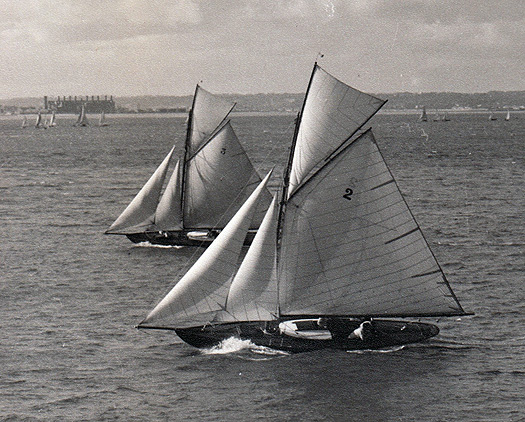
Summer Saturday afternoon in Dublin Bay, and two DBSC 21s make smooth windward progress
Our final DBSC 21 photo today shows an idyllic Saturday afternoon scene in Dublin Bay in the late 1950s. Though the tiller on the nearer boat is quite markedly across the deck, that could be something to do with a loose arrangement with the head of the rudder stock - the wake suggests the rudder was not being heavily deployed as the boat makes sweetly to windward. In all, a poignant photo as we see the boats doing what they were meant to do, not what they're doing now.
NAOMH BAIRBRE IS BACK WITH A BANG
If you thought the original rig on the DBSC 21s was something of a widowmaker, wait till you see the gaff mainsail on the Naomh Bairbre. With the depths of February almost upon us, any images of Irish summer sailing are welcome, and TG4 has an intriguing 6-part series running on Thursday evenings at 9.30pm. It's about taking the Galway Hooker Naomh Bairbre along the Gaelic seaways from Conamara round the south coast of Ireland to the Isle of Man, then north to the Outer Hebrides before returning to Galway via Ireland's north and west coasts. The idea is that this will make clear the lively cross-water links maintained by the people along the Celtic fringe.
The Naomh Bairbre is named for St Barbara, the patron saint of sudden surprises and explosions, and at 47ft is probably the biggest Galway Hooker ever created. She was built in Chicago over a three year period by Steve Mulkerrins, and then in 2006 with the late great Tom Joyce of Inis Mor as skipper, she made an exemplary Transatlantic crossing.
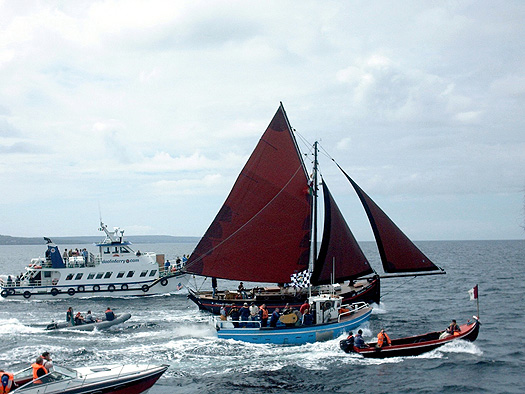
The majestic Naomh Bairbre got a rapturous welcome when she arrived from America in Conamara in July 2006
She really is huge, but since that voyage six years ago we've heard little about her, so it's good to see the big lady in action again. There have been some good sequences of sailing – the first episode particularly had keen camera work – but as so often happens, trying to link a cruise with the development of a narrative about the coasts being visited is a difficult business. Sometimes when cruising you have to accept that having a boat can be just about the least effective way of visiting anywhere. The needs of the boat take over the project, and any relationship with life on the shore is dominated by these immediate maritime requirements rather than following up gentle lines of enquiry about history and the local way of life.
Thus a passage through the Crinan Canal to take in a visit to the ancient fortess of Dunadd, former capital of the 6th Century cross-channel kingdom of Dal Riada, is rather taken over by the difficulties of getting the mettlesome Naomh Bairbre – still with her battering-ram of a bowsprit fully extended – manoeuvred through the narrow canal. She had certainly arrived in Ardrishaig with a bang, but that's St Barbara for you.
We left the crew of three just about to reach Iona on Thursday evening, and look forward to the remaining four programmes. It really is a challenge to take a boat whose design evolved to sail on a reach between Conmara and the Aran Islands through tricky rocky channels which run every which way, and we're with them all the way.
OUR FEATHERED FRIEND
Yesterday's item about the dolphin in Hawaii which successfully sought help from a diver in getting cleared of a fishing line caught tightly round its head, with a hook embedded in one of its fins, recalled a story told me by Dermot Russell, that wordsmith extraordinaire and ace fisherman of Blackrock, Cork.
Dermot and a couple of friends used to head seaward down Cork Harbour in a little boat for a spot of sea angling most summer weekends. As they were good at the fishing they were always accompanied by herring gulls, for herring gulls didn't get to be one of the most successful species on the planet by backing losers.
One day they noted one of their feathered friends was in distress with its beak clamped shut by a fishing line. The bird was so weakened by hunger that they were able to capture it, in fact they reckon the creature was actually seeking help. Clearing the line was managed despite the increasing hazard to the helpers as the razor-sharp beak was freed. But in the end there seemed to be an extra trans-species understanding about it all. As Dermot put it: "I don't suppose you've ever been thanked by a seagull, but I know we were".
Comment on this story?
Leave a message in the box below or email William Nixon on [email protected]































































